Spatiotemporal Changes of Urban Rainstorm-Related Micro-Blogging Activities in Response to Rainstorms: A Case Study in Beijing, China
Abstract
:Featured Application
Abstract
1. Introduction
2. Study Area and Data
2.1. Study Area
2.2. Data
3. Methods
3.1. Extraction of Rainstorm-Related Weibo Posts
3.2. Weibo Blogging Index
3.3. Statistical Analysis
4. Analysis and Results
4.1. The “622” Rainstorm
4.2. Blogging Activities at City Level
4.3. Human Response at Grid Scale
4.4. Factors Influencing HERI
5. Conclusions
Author Contributions
Funding
Conflicts of Interest
References
- Klomp, J.; Valckx, K. Natural disasters and economic growth: A meta-analysis. Glob. Environ. Chang. 2014, 26, 183–195. [Google Scholar] [CrossRef]
- Cole, S.A.; Healy, A.; Werker, E. Do Voters Appreciate Responsive Governments? Evidence from Indian Disaster Relief. Soc. Sci. Electron. Publ. 2012, 97, 167–181. [Google Scholar] [CrossRef]
- Parenton, F.V.J. Disaster and Aftermath: Selected Aspects of Individual and Group Behavior in Critical Situation. Soc. Forces 1959, 38, 129–135. [Google Scholar]
- Ramseur, J.L. Oil Spills in U.S. Coastal Waters: Background, Governance, and Issues for Congress; Congressional Research Service Reports; Library of Congress, Congressional Research Service: Washington, DC, USA, 2010. [Google Scholar]
- Aalst, M.K.V. The Impacts of Climate Change on the Risk of Natural Disasters. Disasters 2006, 30, 5–18. [Google Scholar] [CrossRef] [PubMed]
- Mendelsohn, R.; Emanuel, K.; Chonabayashi, S.; Bakkensen, L. The impact of climate change on global tropical cyclone damage. Nat. Clim. Chang. 2012, 2, 205–209. [Google Scholar] [CrossRef]
- Goodchild, M.F. Citizens as sensors: The world of volunteered geography. GeoJournal 2007, 69, 211–221. [Google Scholar] [CrossRef]
- Wang, Z.; Ye, X. Social media analytics for natural disaster management. Int. J. Geogr. Inf. Sci. 2017, 32, 1–24. [Google Scholar] [CrossRef]
- Liu, Y.; Liu, X.; Gao, S.; Gong, L.; Kang, C.G.; Zhi, Y.; Chi, G.H.; Shi, L. Social Sensing: A New Approach to Understanding Our Socioeconomic Environments. Ann. Assoc. Am. Geogr. 2015, 105, 512–530. [Google Scholar] [CrossRef]
- Linet, Ö.; Ekinci, E.; Beste, K. Emergency Logistics Planning in Natural Disasters. Ann. Op. Res. 2004, 129, 217–245. [Google Scholar]
- De, V.P.; Guilbert, N.; Mesple-Somps, S. Impact of Natural Disasters on Education Outcomes: Evidence from the 1987-89 Locust Plague in Mali. J. Afr. Econ. 2015, 24, 57–100. [Google Scholar]
- Nie, C.J.; Yang, L.S.; Li, H. Macro Assessment of Seismic Population Vulnerability in China. Progress Geogr. 2012, 31, 375–382. [Google Scholar]
- Khunwishit, S. Community Resilience in Thailand: A Case Study of Flood Response in Nakhonsawan City Municipality; University of North Texas: Denton, Texas, 2013. [Google Scholar]
- Morss, R.E.; Wilhelmi, O.V.; Meehl, G.A.; Dilling, L. Improving Societal Outcomes of Extreme Weather in a Changing Climate: An Integrated Perspective. Ann. Rev. Environ. Resour. 2011, 36, 1–25. [Google Scholar] [CrossRef] [Green Version]
- Lazer, D.; Pentland, A.; Adamic, L. Computational Social Science. Science 2009, 323, 721–723. [Google Scholar] [CrossRef] [PubMed] [Green Version]
- Vespignani, A. Predicting the Behavior of Techno-Social Systems. Science 2009, 325, 425–428. [Google Scholar] [CrossRef] [PubMed]
- Bai, H.; Yu, G.A. Weibo-based approach to disaster informatics: Incidents monitor in post-disaster situation via Weibo text negative sentiment analysis. Nat. Hazards 2016, 83, 1177–1196. [Google Scholar] [CrossRef]
- Li, Z.; Wang, C.; Emrich, C.T. A novel approach to leveraging social media for rapid flood mapping: A case study of the 2015 South Carolina floods. Cartogr. Geogr. Inf. Sci. 2017, 45, 97–110. [Google Scholar] [CrossRef]
- Neppalli, V.K.; Caragea, C.; Squicciarini, A.; Tapia, A.; Stehle, S. Sentiment analysis during Hurricane Sandy in emergency response. Int. J. Disaster Risk Reduct. 2017, 21, 213–222. [Google Scholar] [CrossRef] [Green Version]
- Cvetojevic, S.; Hochmair, H.H. Analyzing the spread of tweets in response to Paris attacks. Comput. Environ. Urban Syst. 2018, 71, 14–26. [Google Scholar] [CrossRef]
- Chunara, R.; Andrews, J.R.; Brownstein, J.S. Social and News Media Enable Estimation of Epidemiological Patterns Early in the 2010 Haitian Cholera Outbreak. Am. J. Trop. Med. Hyg. 2012, 86, 39–45. [Google Scholar] [CrossRef] [Green Version]
- Vieweg, S. Microblogging during two natural hazards events: What twitter may contribute to situational awareness. In SIGCHI Conference on Human Factors in Computing Systems; ACM: Museum, Singapore, 2010. [Google Scholar]
- Caragea, C.; McNeese, N.; Jaiswal, A.; Traylor, G.; Kim, H.-W. Classifying text messages for the Haiti earthquake. In Proceedings of the 8th International Conference on Information Systems for Crisis Response and Management, New York, NY, USA, 20–23 May 2011. [Google Scholar]
- Freeman, M. Fire, Wind and Water: Social Networks in Natural Disasters; IGI Global: Pennsylvania, NY, USA, 2011. [Google Scholar]
- Stewart, K.; Glanville, J.L.; Bennett, D.A. Exploring Spatiotemporal and Social Network Factors in Community Response to a Major Flood Disaster. Prof. Geogr. 2014, 66, 421–435. [Google Scholar] [CrossRef]
- Chae, J.; Thom, D.; Bosch, H. Spatiotemporal Social Media Analytics for Abnormal Event Detection using Seasonal-Trend Decomposition. In Proceedings of the IEEE Conference on Visual Analytics Science & Technology, Seattle, WA, USA, 14–19 October 2012; IEEE Computer Society: Washington, DC, USA, 2012. [Google Scholar]
- Dong, X.; Mavroeidis, D.; Calabrese, F. Multiscale event detection in social media. Data Min. Knowl. Discov. 2015, 29, 1374–1405. [Google Scholar] [CrossRef]
- Brennan, S.; Sadilek, A.; Kautz, H. Towards understanding global spread of disease from everyday interpersonal interactions. In Proceedings of the twenty-third international joint conference on artificial intelligence, Beijing, China, 3–19 August 2013; AAAI Press: Beijing, China, 2013; pp. 2783–2789. [Google Scholar]
- Magdy, W.; Darwish, K.; Abokhodair, N. Quantifying Public Response towards Islam on Twitter after Paris Attacks. arXiv 2015, arXiv:1512.04570. [Google Scholar]
- Berger, L. Local, National and Global Islam: Religious Guidance and European Muslim Public Opinion on Political Radicalism and Social Conservatism. West Eur. Politics 2016, 39, 205–228. [Google Scholar] [CrossRef]
- Kryvasheyeu, Y.; Chen, H.; Obradovich, N. Rapid assessment of disaster damage using social media activity. Sci. Adv. 2016, 2, e1500779. [Google Scholar] [CrossRef] [PubMed]
- Fohringer, J.; Dransch, D.; Kreibich, H. Social media as an information source for rapid flood inundation mapping. Nat. Hazards Earth Syst. Sci. 2015, 15, 2725–2738. [Google Scholar] [CrossRef] [Green Version]
- Takahashi, B.; Tandoc, E.C.; Carmichael, C. Communicating on Twitter during a disaster: An analysis of tweets during Typhoon Haiyan in the Philippines. Comput. Hum. Behav. 2015, 50, 392–398. [Google Scholar] [CrossRef]
- Rosser, J.F.; Leibovici, D.G.; Jackson, M.J. Rapid flood inundation mapping using social media, remote sensing and topographic data. Nat. Hazards 2017, 87, 103–120. [Google Scholar] [CrossRef] [Green Version]
- Houston, J.B.; Hawthorne, J.; Perreault, M.F. Social media and disasters: A functional framework for social media use in disaster planning, response, and research. Disasters 2014, 39, 1–22. [Google Scholar] [CrossRef]
- Kryvasheyeu, Y.; Chen, H.; Moro, E. Performance of Social Network Sensors during Hurricane Sandy. PLoS ONE 2015, 10, e0117288. [Google Scholar] [CrossRef]
- Zou, L.; Lam, N.S.N.; Cai, H. Mining Twitter Data for Improved Understanding of Disaster Resilience. Ann. Am. Assoc. Geogr. 2018, 108, 1–20. [Google Scholar] [CrossRef]
- Wu, D.; Cui, Y. Disaster early warning and damage assessment analysis using social media data and geo-location information. Decis. Support Syst. 2018, 111, 48–59. [Google Scholar] [CrossRef]
- Yago, M.; Li, Z.; Cutter, S.L. Leveraging Twitter to gauge evacuation compliance: Spatiotemporal analysis of Hurricane Matthew. PLoS ONE 2017, 12, e0181701. [Google Scholar]
- Resch, B.; Florian, U.; Havas, C. Combining machine-learning topic models and spatiotemporal analysis of social media data for disaster footprint and damage assessment. Cartogr. Geogr. Inf. Sci. 2017, 45, 362–376. [Google Scholar] [CrossRef] [Green Version]
- Weibo User Development Report for 2018. Available online: https://data.weibo.com/report/reportDetail?id=433 (accessed on 15 May 2019).
- Zahra, K.; Ostermann, F.O.; Purves, R.S. Geographic variability of Twitter usage characteristics during disaster events. Geo-sp. Inf. Sci. 2017, 20, 231–240. [Google Scholar] [CrossRef] [Green Version]
- Aramaki, E.; Maskawa, S.; Morita, M. Twitter Catches the Flu: Detecting Influenza Epidemics Using Twitter; Emnlp: AsiaWorld-Expo, Hong Kong, China, 2011. [Google Scholar]
- Dilrukshi, I.; Zoysa, K.D.; Caldera, A. Twitter news classification using SVM. In Proceedings of the International Conference on Computer Science & Education, Kuala Lumpur, Malaysia, 29 November–1 December 2013; IEEE: Piscataway, NJ, USA, 2013. [Google Scholar]
- Zhang, H.; Chen, L.; Qu, Y. Support Vector Regression Based on Grid-Search Method for Short-Term Wind Power Forecasting. J. Appl. Math. 2014, 2014, 1–11. [Google Scholar] [CrossRef]
- Gao, Y.; Wang, S.; Padmanabhan, A. Mapping spatiotemporal patterns of events using social media: A case study of influenza trends. Int. J. Geogra. Inf. Sci. 2018, 32, 425–449. [Google Scholar] [CrossRef]
- Hanley, J.A.; Mcneil, B.J. The meaning and use of the area under a receiver operating characteristic (ROC) curve. Radiology 1982, 143, 29–36. [Google Scholar] [CrossRef]
- Cook, N.R. Use and Misuse of the Receiver Operating Characteristic Curve in Risk Prediction. Circulation 2007, 115, 928–935. [Google Scholar] [CrossRef] [Green Version]
- Wang, Y.; Wang, T.; Tsou, M.-H. Mapping Dynamic Urban Land Use Patterns with Crowdsourced Geo-Tagged Social Media (Sina-Weibo) and Commercial Points of Interest Collections in Beijing, China. Sustainability 2016, 8, 1202. [Google Scholar] [CrossRef]
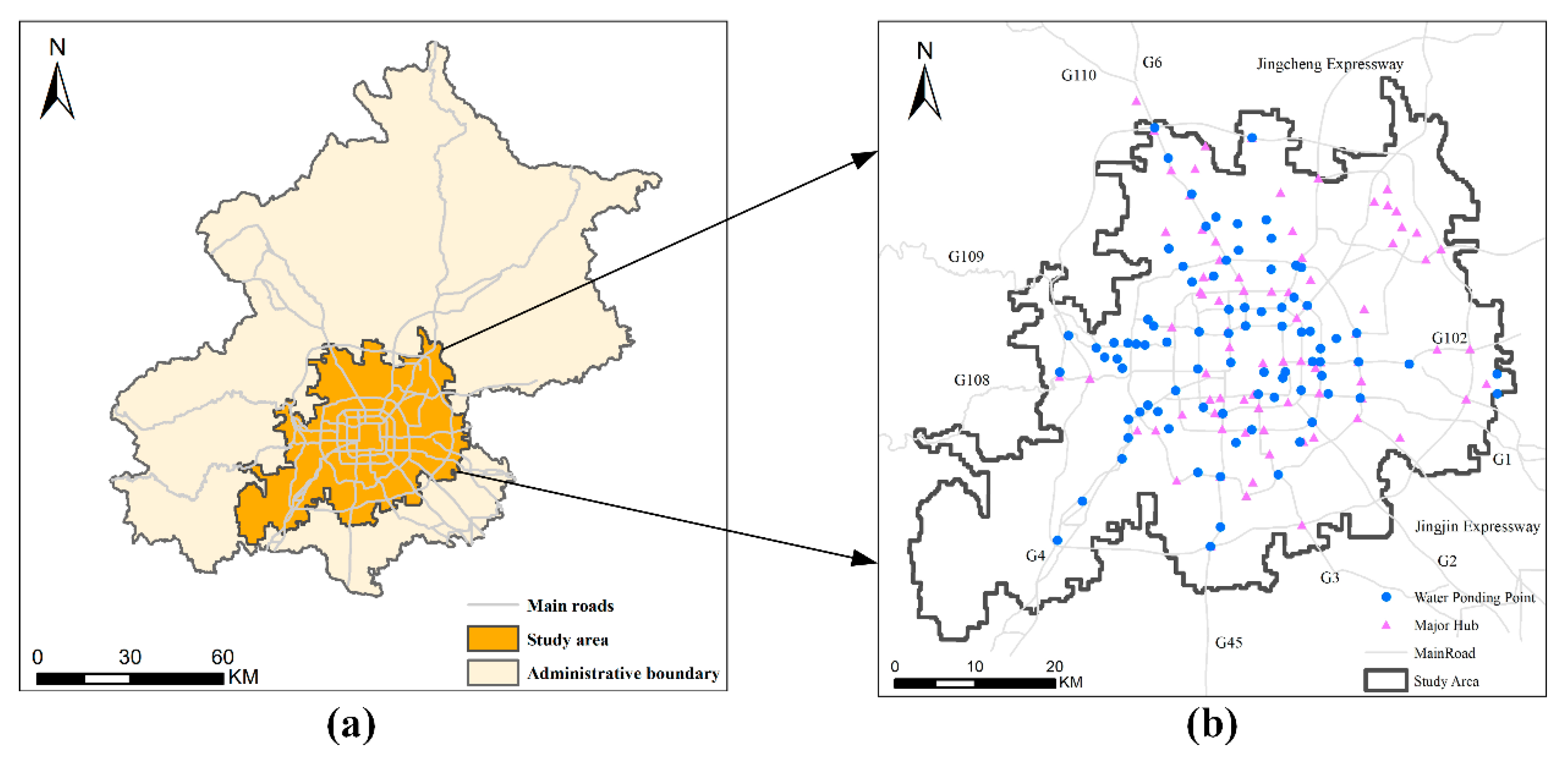
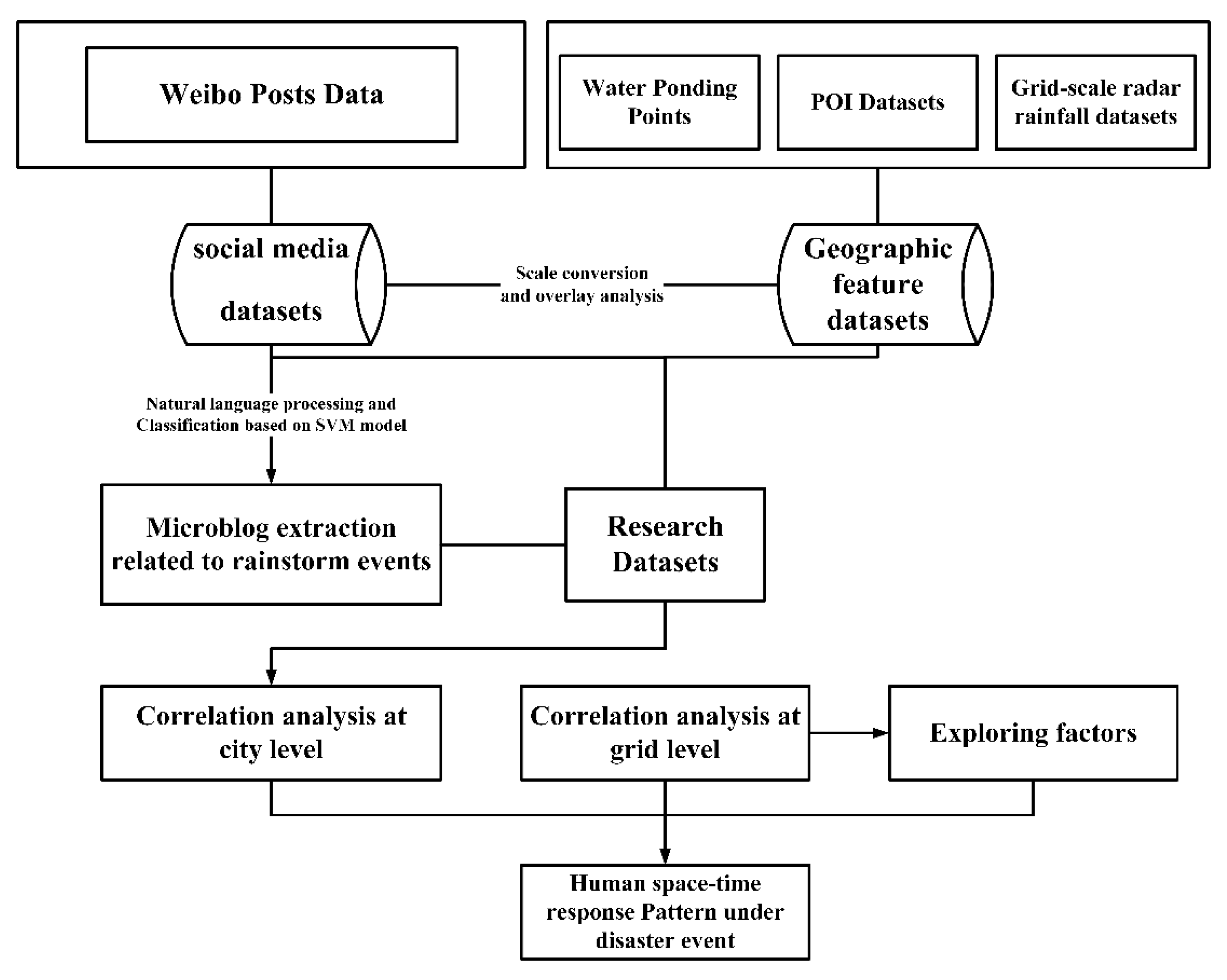
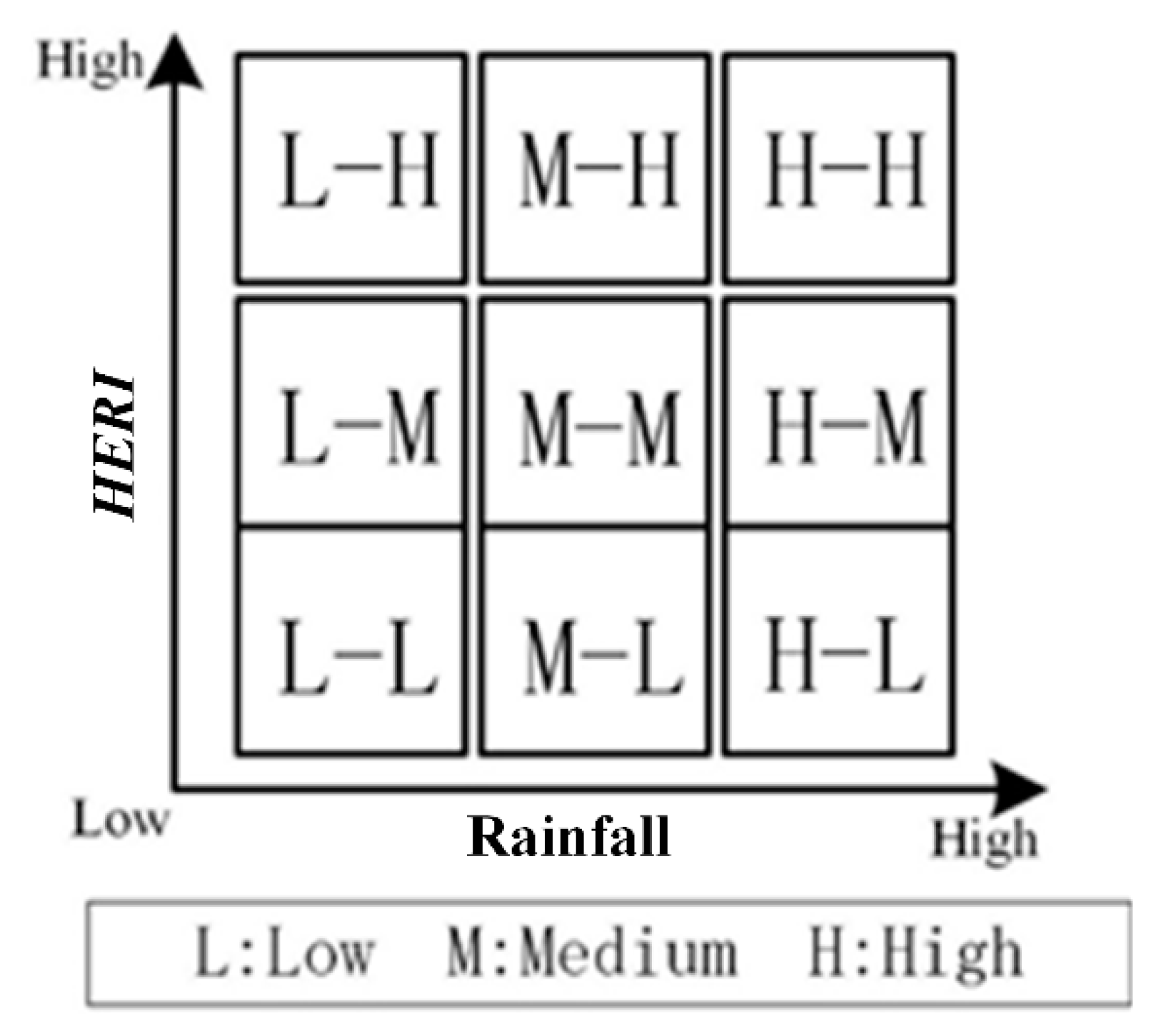

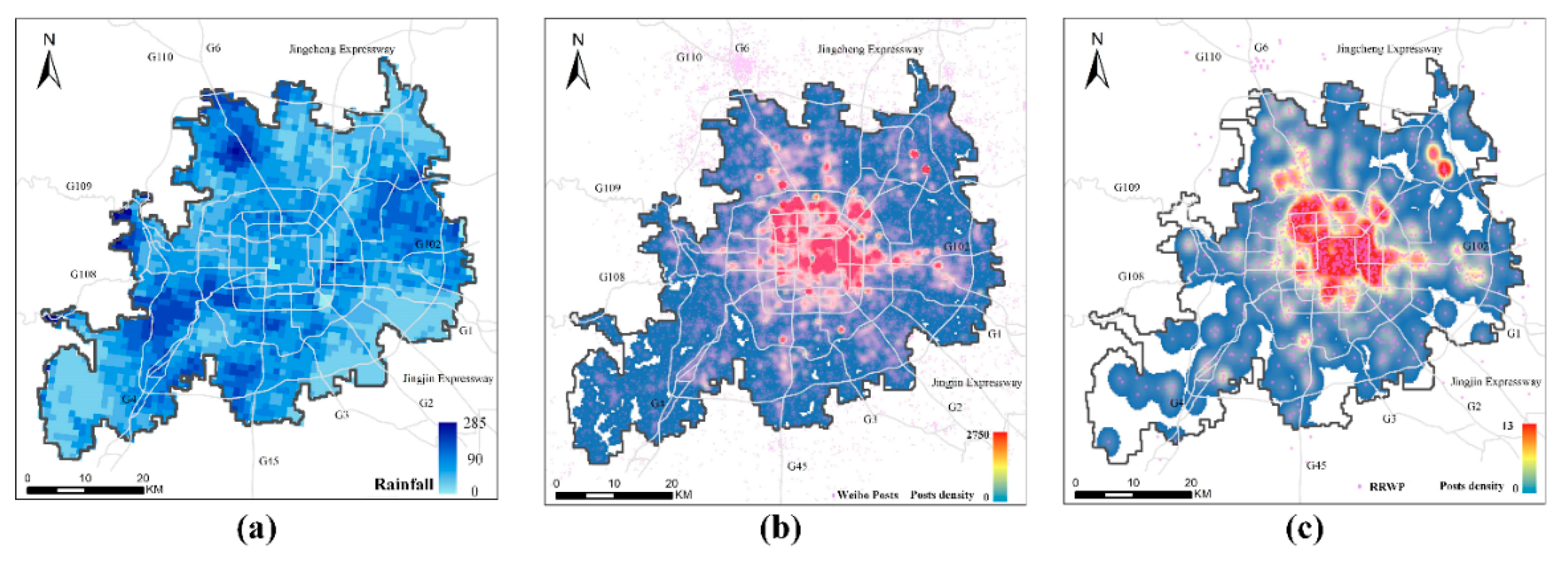
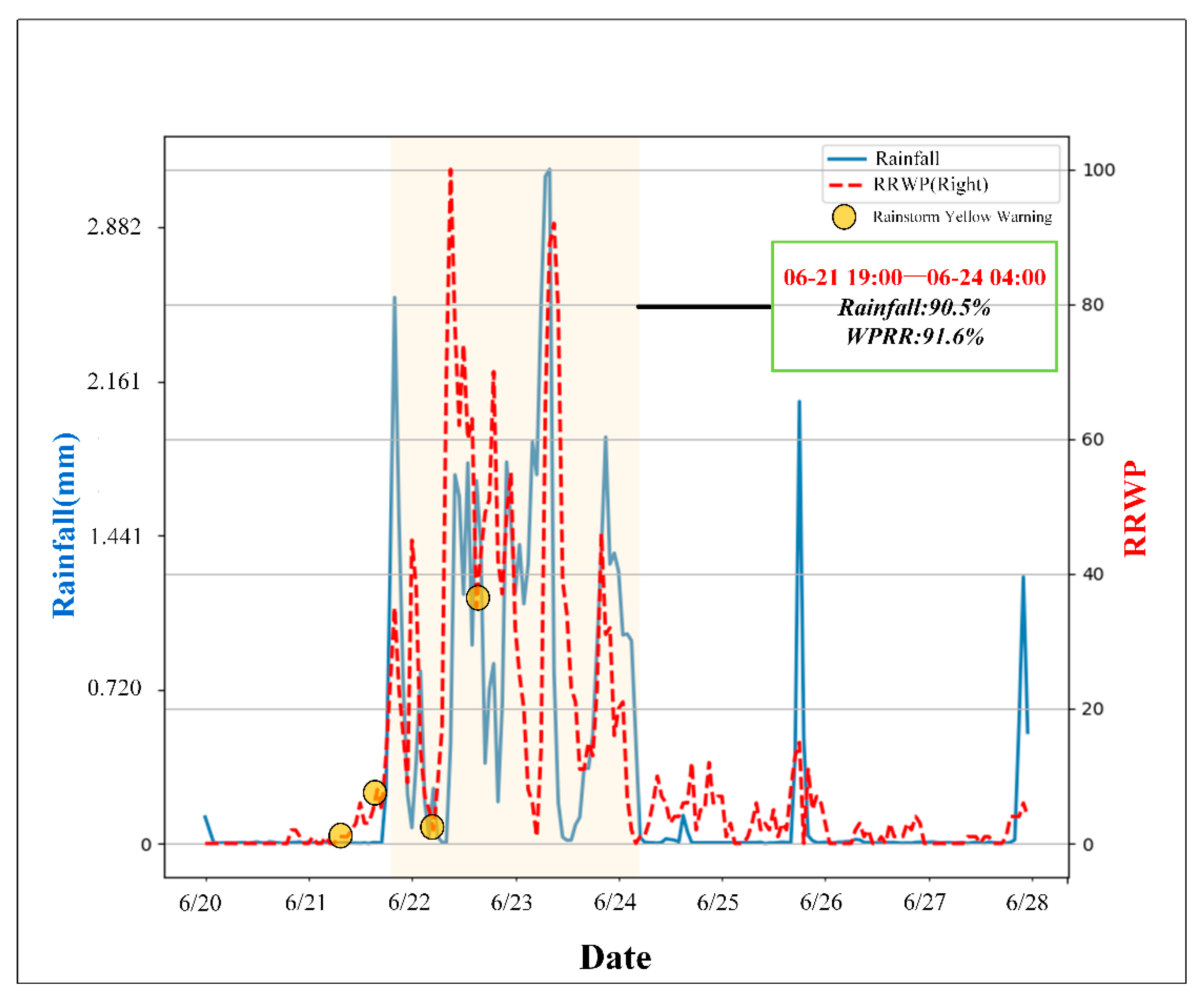
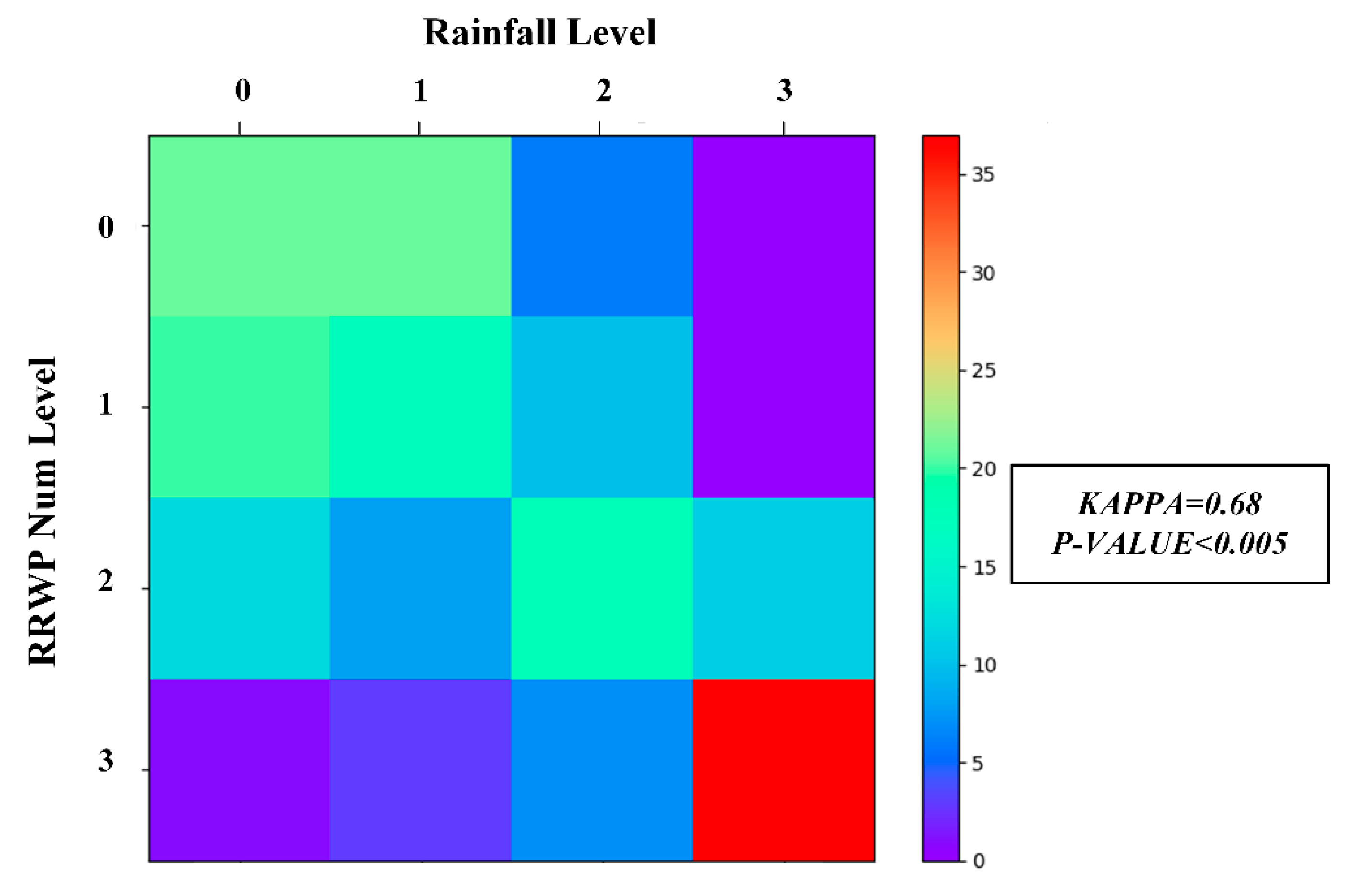
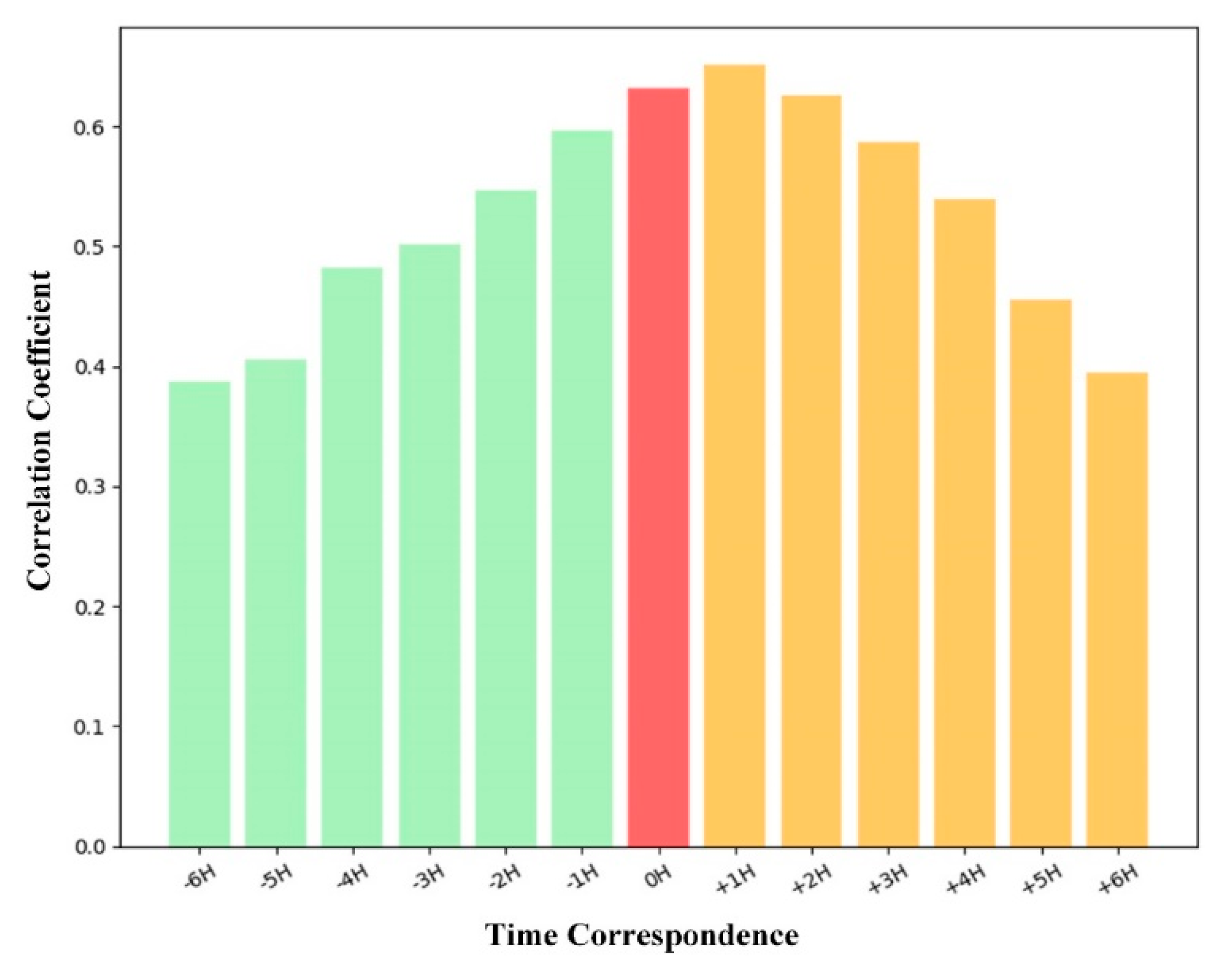
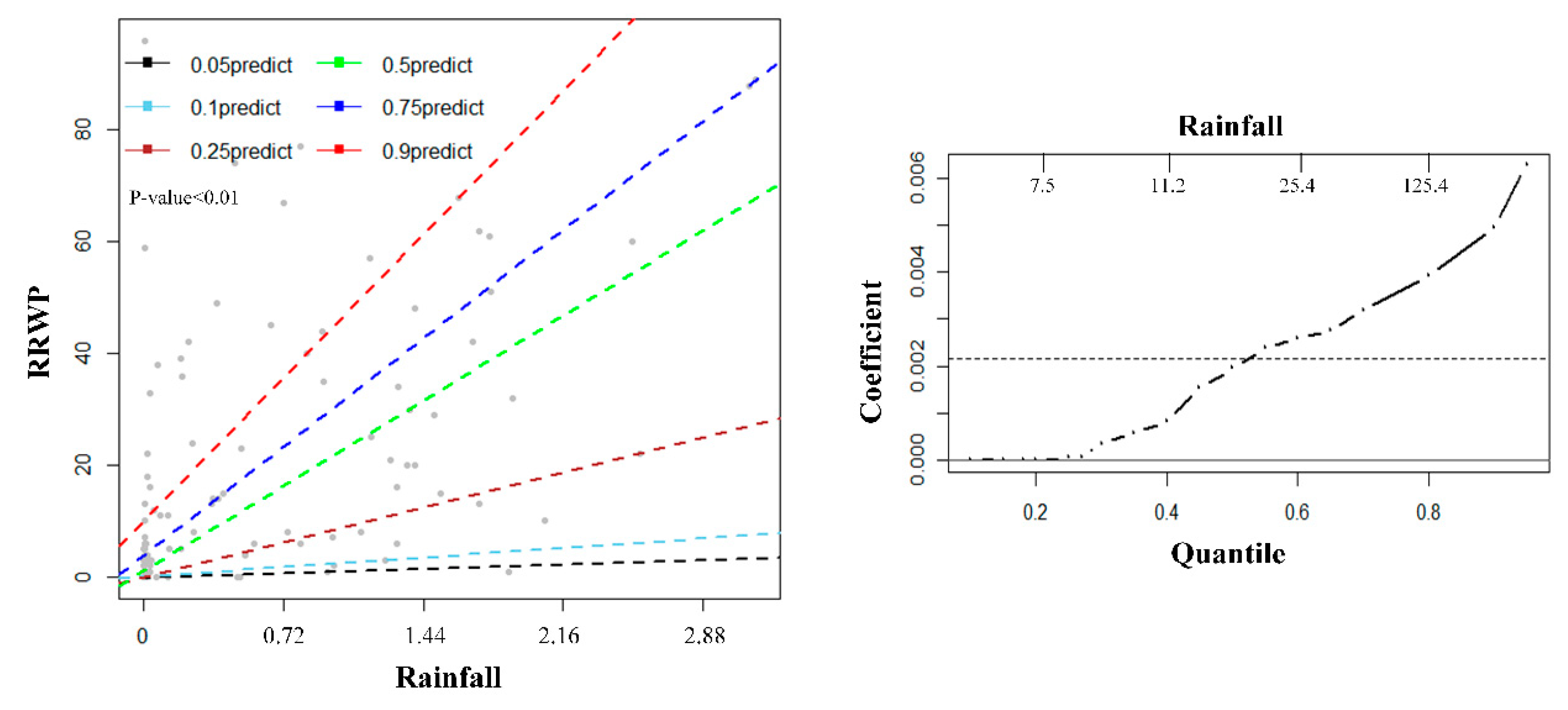
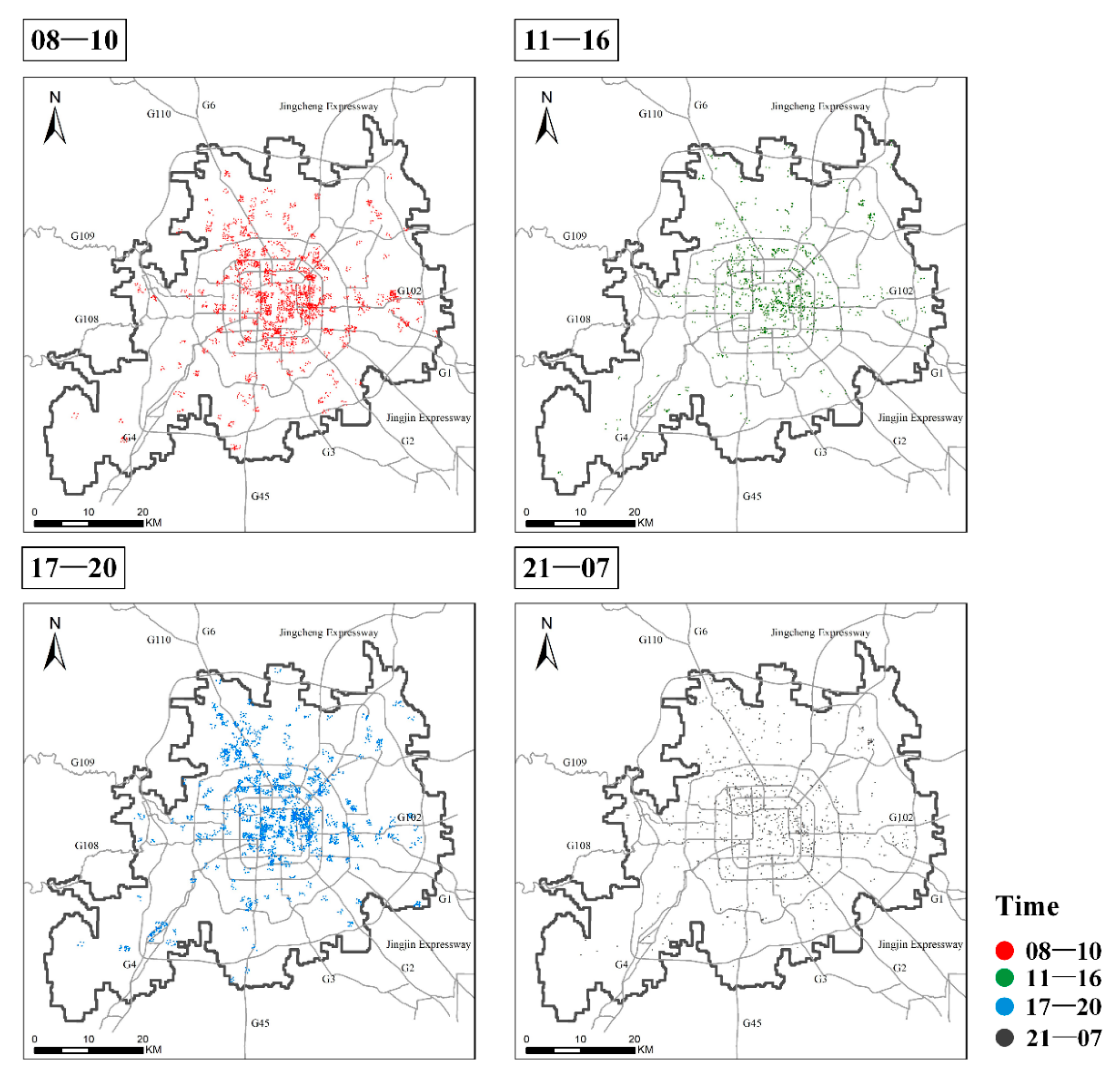
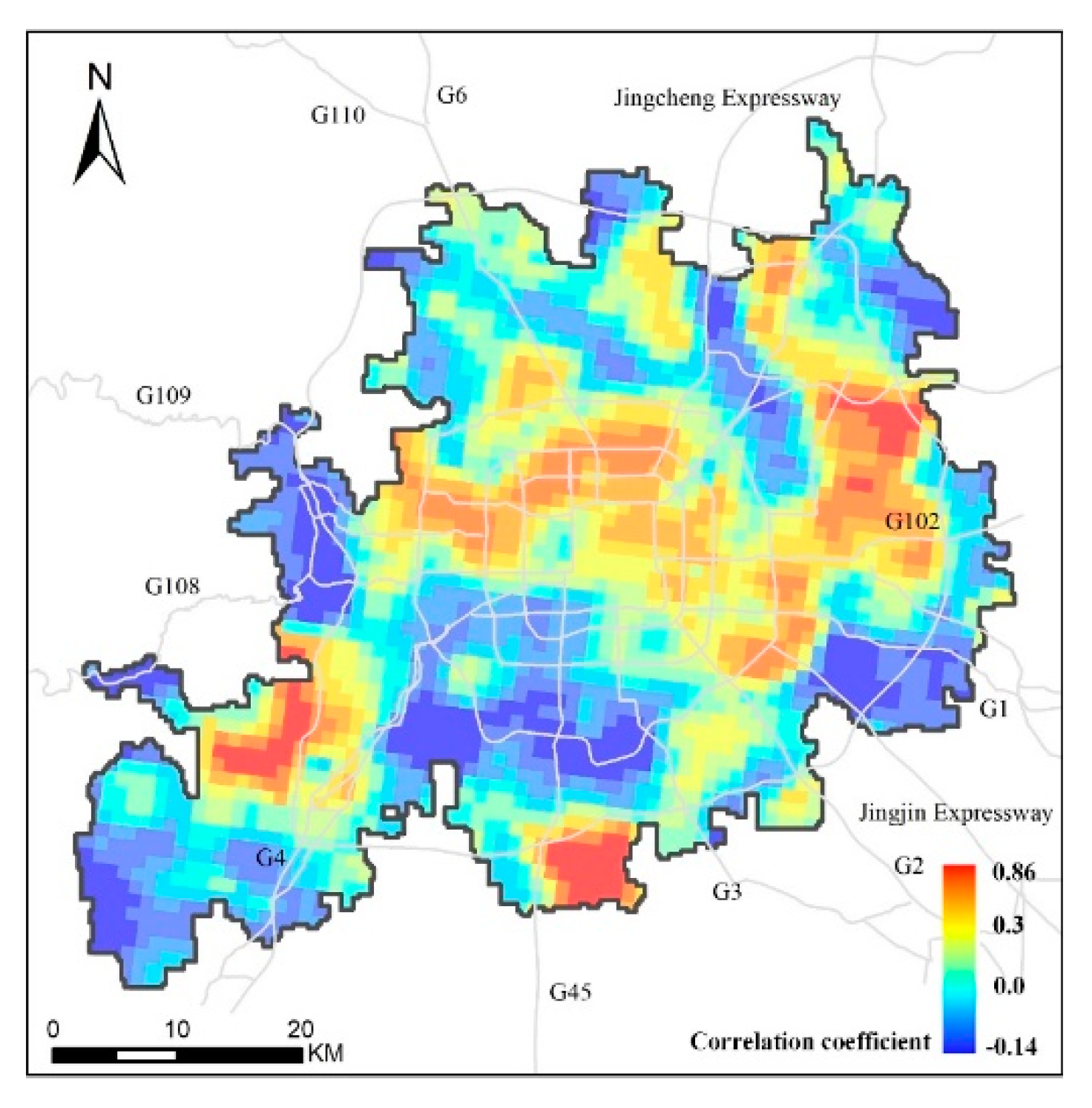
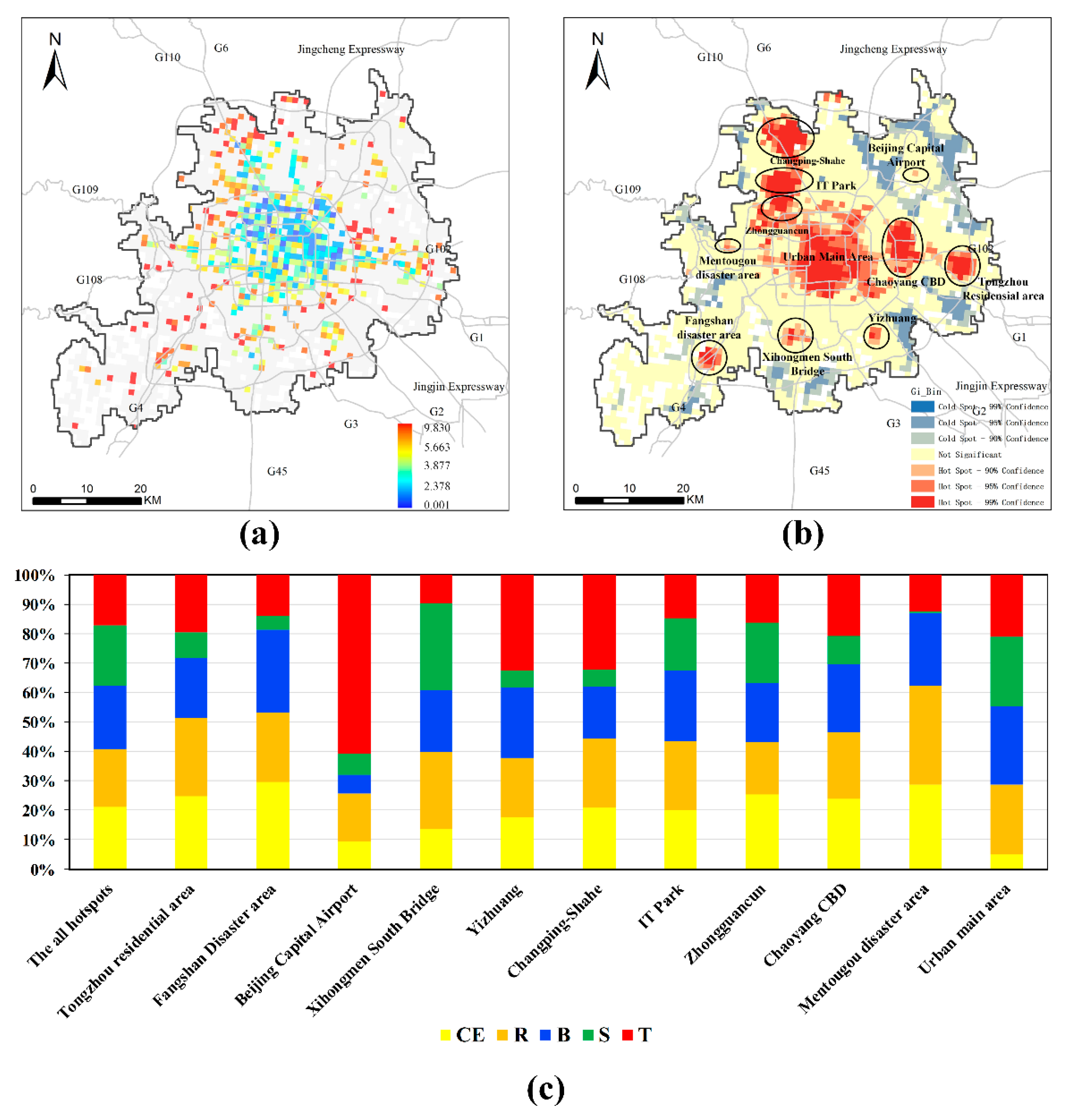
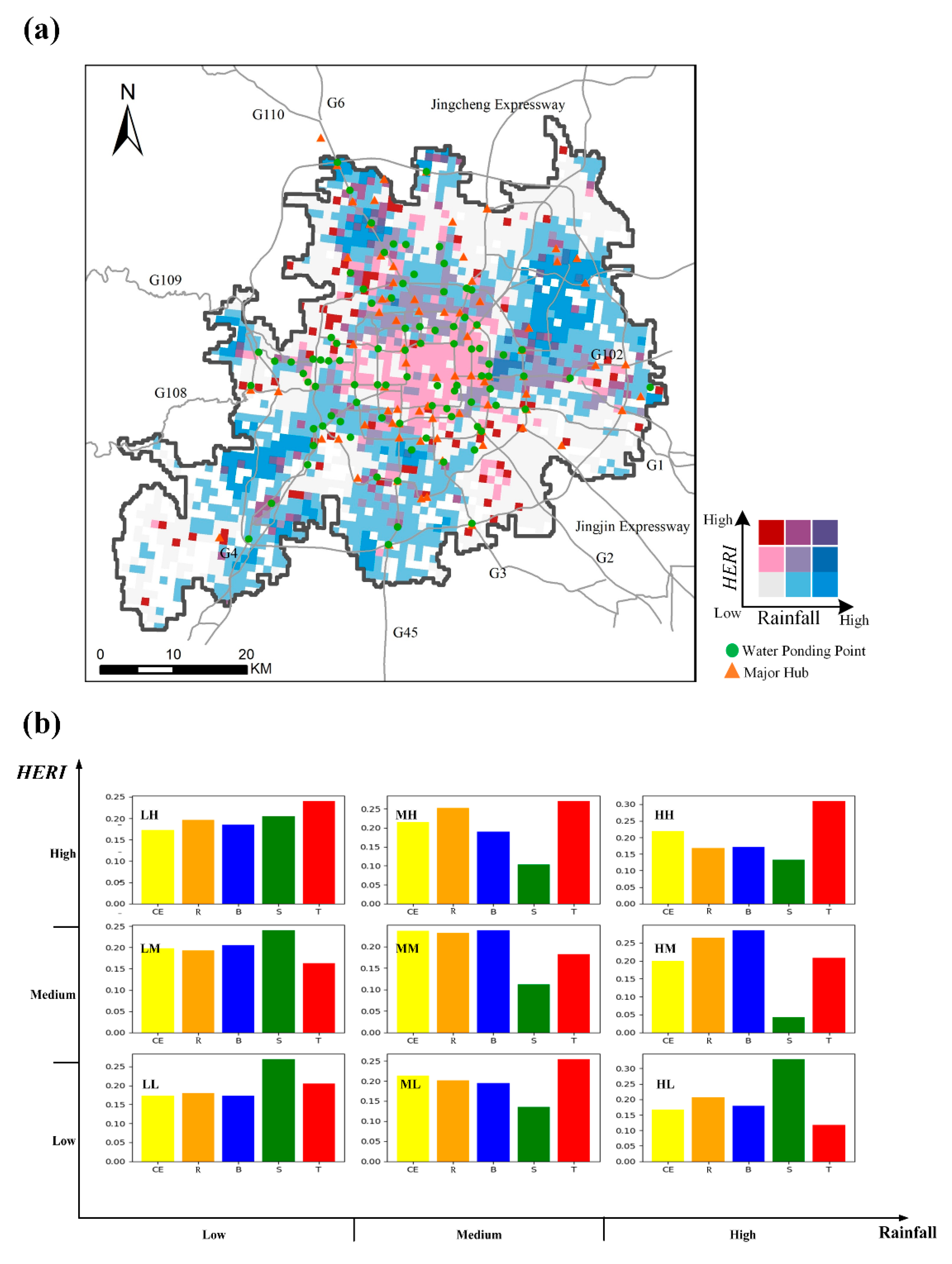
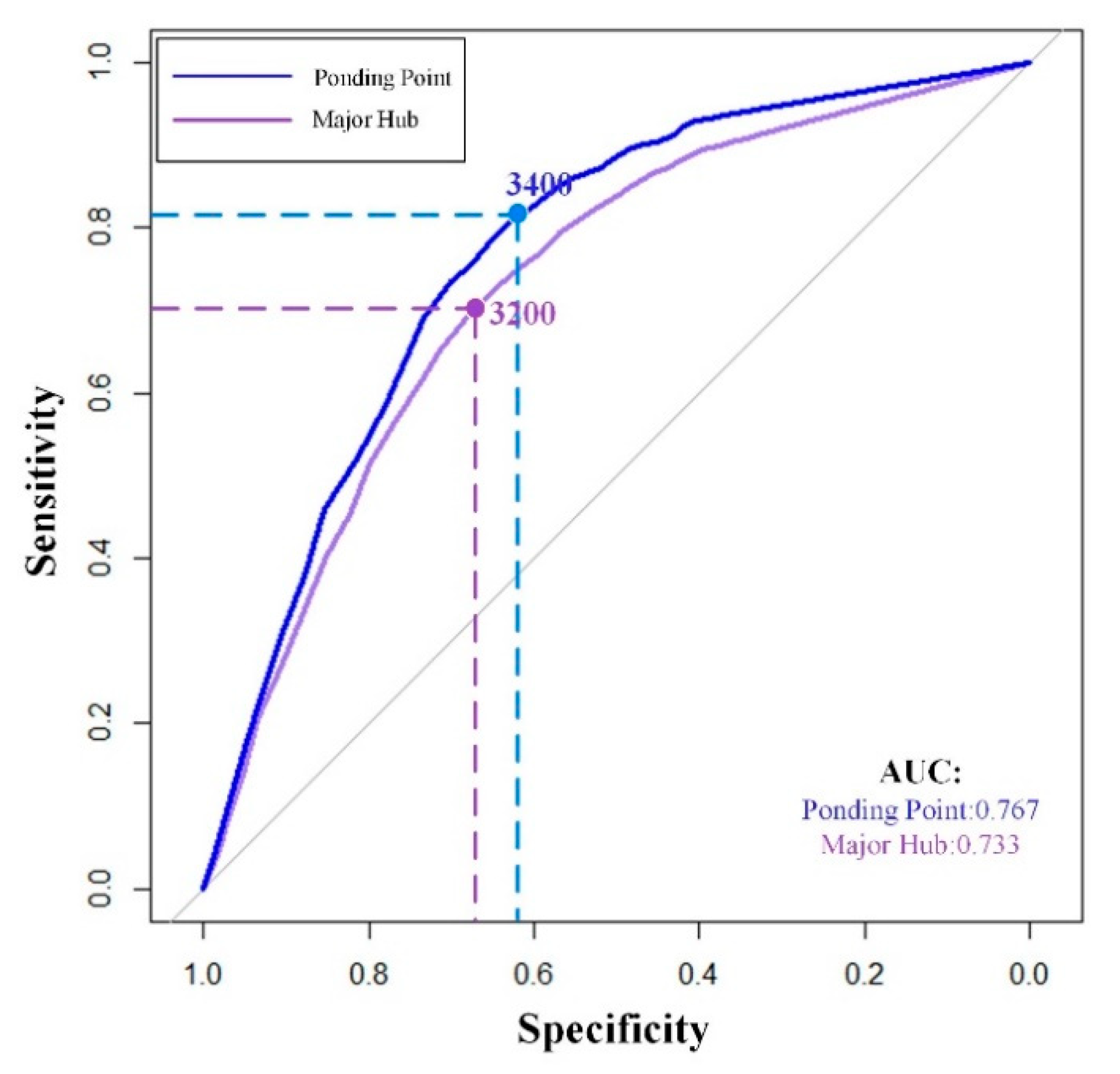
| POI Class | Abbreviations | Total Numbers |
|---|---|---|
| Common Service and Education Culture | CE | 1,402,310 |
| Residential | R | 977,745 |
| Business | B | 6,695,615 |
| Scenic area and Green Open Space | S | 264,065 |
| Transportation facilities | T | 299,360 |
| ENRR | Area(km2) | Water Ponding Points | Major Transportation Hubs | ||
|---|---|---|---|---|---|
| Number | Density | Number | Density | ||
| LRLP | 915 | 35 | 3.8 | 25 | 2.7 |
| ML | 702 | 29 | 4.1 | 14 | 2.0 |
| HL | 202 | 4 | 2.0 | 10 | 5.0 |
| LM | 228 | 27 | 11.8 | 17 | 7.5 |
| MM | 182 | 15 | 8.2 | 16 | 8.8 |
| HM | 19.4 | 3 | 15.5 | 1 | 5.2 |
| LH | 82.5 | 6 | 7.3 | 9 | 10.9 |
| MH | 79 | 11 | 13.9 | 6 | 7.6 |
| HH | 22.8 | 3 | 13.2 | 2 | 8.8 |
© 2019 by the authors. Licensee MDPI, Basel, Switzerland. This article is an open access article distributed under the terms and conditions of the Creative Commons Attribution (CC BY) license (http://creativecommons.org/licenses/by/4.0/).
Share and Cite
Wang, N.; Du, Y.; Liang, F.; Yi, J.; Wang, H. Spatiotemporal Changes of Urban Rainstorm-Related Micro-Blogging Activities in Response to Rainstorms: A Case Study in Beijing, China. Appl. Sci. 2019, 9, 4629. https://doi.org/10.3390/app9214629
Wang N, Du Y, Liang F, Yi J, Wang H. Spatiotemporal Changes of Urban Rainstorm-Related Micro-Blogging Activities in Response to Rainstorms: A Case Study in Beijing, China. Applied Sciences. 2019; 9(21):4629. https://doi.org/10.3390/app9214629
Chicago/Turabian StyleWang, Nan, Yunyan Du, Fuyuan Liang, Jiawei Yi, and Huimeng Wang. 2019. "Spatiotemporal Changes of Urban Rainstorm-Related Micro-Blogging Activities in Response to Rainstorms: A Case Study in Beijing, China" Applied Sciences 9, no. 21: 4629. https://doi.org/10.3390/app9214629
APA StyleWang, N., Du, Y., Liang, F., Yi, J., & Wang, H. (2019). Spatiotemporal Changes of Urban Rainstorm-Related Micro-Blogging Activities in Response to Rainstorms: A Case Study in Beijing, China. Applied Sciences, 9(21), 4629. https://doi.org/10.3390/app9214629






